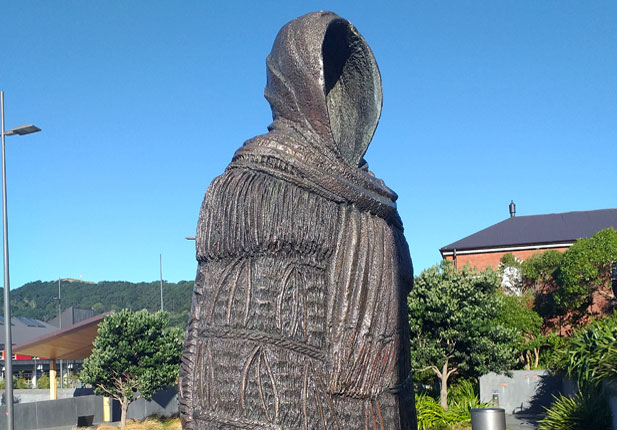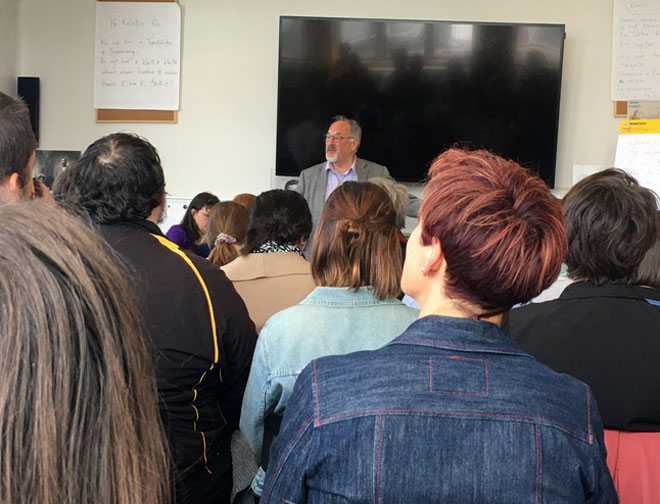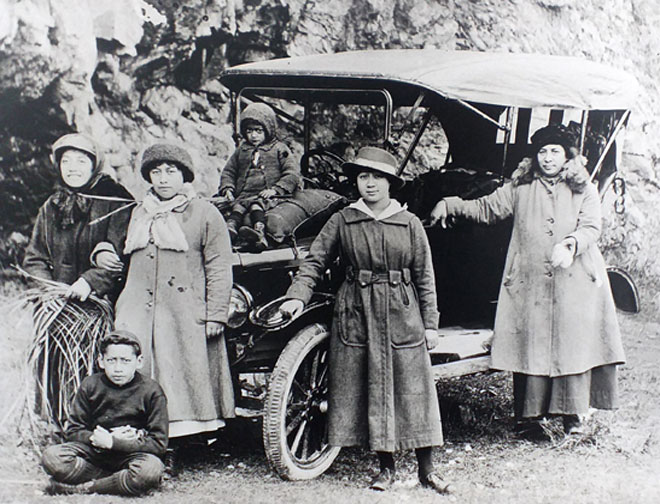
Morrie Love, former Waitangi Tribunal Director and chair of the Wellington Tenths Trust Chair has long been a stalwart of Pukeahu National War Memorial Park.
As a champion of a mana whenua presence in the Park, he was instrumental in developing Ngā Tapuwae o te Kāhui Maunga (in the footsteps of the ancestors/Kāhui Maunga), the memorial garden on either side of the steps leading up to the Carillon Tower and the Hall of Memories on Buckle St in central Wellington.
Morrie Love and the Te Āti Awa whānau include daughter Honiana Love (CE of Ngā Taonga Sound & Vision), Sam and June Jackson (both now deceased), Peter Jackson (son of Sam and June; not the film-maker), and most recently Pekaira Jude Rei. They act as the Park’s kaitiaki (guardians), being part of the official parties for all ceremonies held at Pukeahu. Their mana and matauranga Māori support appropriate cultural practices and guide the staff and visitors to learn more about the layers of history at the Park.
Listen to Morrie talk about the opening of the Park, in an interview on RNZ.
Morrie has been wrapping up his official duties here in Te Ūpoko o te Ika (Wellington) so that he can write further mana whenua history. But happily, Pukeahu Education Centre enticed him to come back and speak to educators from local institutions and schools, including teachers, students and our own Ministry for Culture and Heritage staff about the development of mana whenua life in the city over time. It was his birthday, so there was cake.

Chris Leach
Morrie Love speaking at Pukeahu Education Centre, 25 October 2019.
Morrie described some of the many pā and kainga which were located around the inner harbour and the south coast of Te Whanganui-a-Tara (Wellington, the Great/Big Harbour of Tara), and how these changed over time due to migration, warring parties and natural events such as the Haowhenua (earth swallower) earthquake in about 1450 which substantially altered the land, causing an island called Motu Kairangi to become Miramar Peninsula. He told us that the land around Pukeahu to the north and south was covered in gardens, acknowledged today in native plants in the memorial gardens. The Basin Reserve was once a lake and a good source of mahinga kai such as eels, watercress and kōura (crayfish).
Morrie revealed that early plans for the Pukeahu National War Memorial Park had not included mana whenua in their designs. He and others subsequently pushed for the inclusion of an appropriate memorial that acknowledged and supported understanding of the substantial contribution of iwi Māori to all the internal and external battles fought by Aotearoa New Zealand. [1] The result was Ngā Tapuwae o te Kāhui Maunga memorial.
Kāhui Maunga refers to ‘pre-iwi Māori’ of the ‘moa-hunter’ era who lived both at Taranaki and in the Wellington region. Their memories are recorded in drawings and etchings on boulders and in caves in various areas around the motu (island, or land). Boulders representing Taranaki, Ruapehu and Tongariro in the memorial echo those drawings and etchings. The gardens which once covered Pukeahu and ran to the north and south are acknowledged in the substantial plantings of rata, flax, renga renga and other native plants in the memorial gardens. Honiana Love described the role of Hinerangi, Darcy Nicholas’ wonderful kuia statue which represents a universal mother figure. She is also the kaikaranga (caller) facing the Tomb of the Unknown Warrior, eternally calling him home.
Morrie talked about the Parihaka Memorial, which is located up on the hill behind the official Park on the possible site of the first prison at Pukeahu. This memorial further encourages the korero regarding tangata whenua struggles all over the motu to retain their whenua, their mana and their rangatiratanga, and particularly the struggle for Parihaka.
Some staff from the Ministry for Culture and Heritage have just been to Te Pūtake o te Riri ki Taranaki – the commemorations of the New Zealand Wars at Waitara, supporting Prime Minister Jacinda Ardern at an extraordinary powhiri. During the three days we were there we heard from descendants of the Parihaka prisoners who used passive resistance to try to maintain their whenua during the 1870s and early 1880s against a powerful government intent on breaking up their village and their way of life. An invasion of their village is still remembered and discussed each year in early November.
Morrie’s korero helped us make links between that time at Waitara and the events at Pukeahu. With the further support of Te Āti Awa mana whenua and other Taranaki whānui, we’ll co-design lessons around the Parihaka Memorial as appropriate.
At the end of the talk, our colleague Leanne Tamaki presented Morrie with Ministry for Culture and Heritage Senior Historian Monty Soutar’s new book, Whitiki! Whiti! Whiti! E!: Maori in the First World War, acknowledging Morrie’s contribution and mana. Lead Educator Historian Steve Watters then responded to Morrie’s whakaaro.
We didn’t record Morrie’s latest talk, but the wonderful Pou Arahi team of the Ministry for Culture and Heritage did film Morrie talking to staff earlier in the year as part of our ongoing Oko speaker series, and this is well worth watching.
The topic of his presentation was the genesis of some of the original names around the Wellington region, including names which originated with the Polynesian navigator Kupe, early iwi Ngāti Mamoe and Ngāi Tahu who travelled through the region and later, Ngāi Tara and Ngāti Ira, and then the current mana whenua, Te Āti Awa and Taranaki whānui. Morrie also discussed significant pā and kainga sites in central Wellington, and also some of the names associated with the New Zealand Company replaced original Māori place names.
The staff of Pukeahu acknowledge Morrie and the Love whānau of Te Āti Awa and Taranaki whānui as an integral part of Pukeahu National War Memorial Park and Te Ūpoko o te Ika. We look forward to continuing to develop our relationship as the Park and the city grow and change.
Kia ora e rangatira! May your future endeavours go well, and thank you for all your mahi at Pukeahu.

Emma Jean Kelly
Parihaka Memorial beside Massey University campus, Wellington.
Emma Jean Kelly, Educator
Further information
- Ngā Tapuwae o te Kāhui Maunga - Pukehau National War Memorial Park
- Hinerangi - National War Memorial Sculpture by Darcy Nicholas
Notes
[1] People involved in the Kāhui Maunga project included Hana Nicholas (née Keenan), Rangitihi Rangiwaiata Tahuparae, and Wiremu Parker. The project manager was Morrie Love; artists: Darcy Nicholas, Rangi Kipa and Verenoa Hetet; technical advice and casting of sculpture: Brett Rangitaawa. Support for Ngā Tapuwae o Kāhui Maunga project came from Wellington Tenths Trust, Palmerston North Maori Reserve Trust and many others.


Community contributions